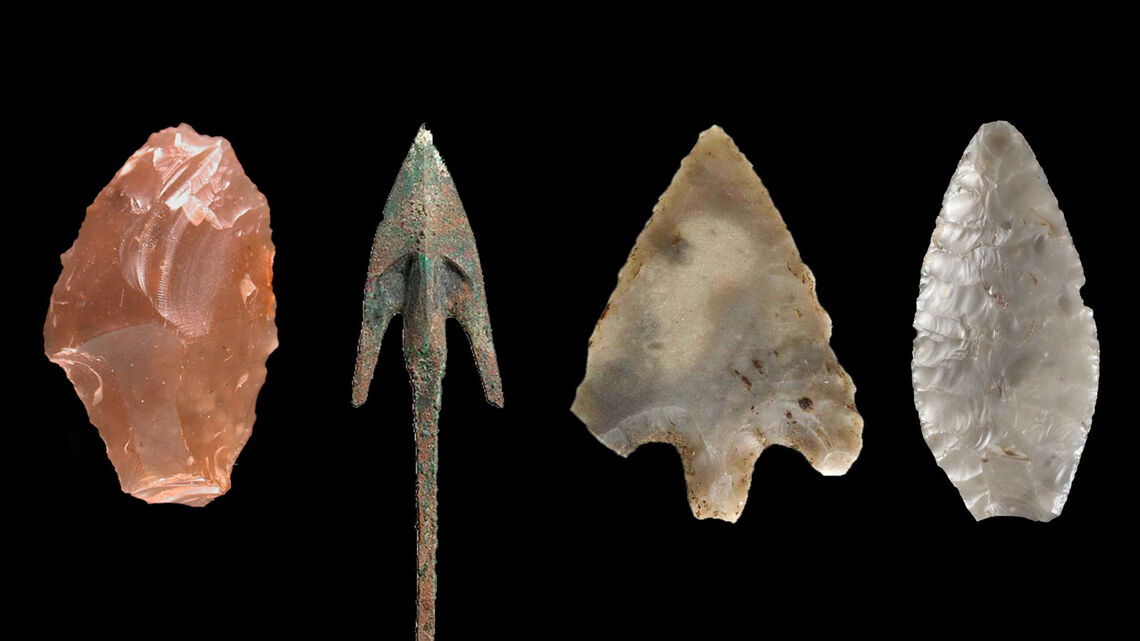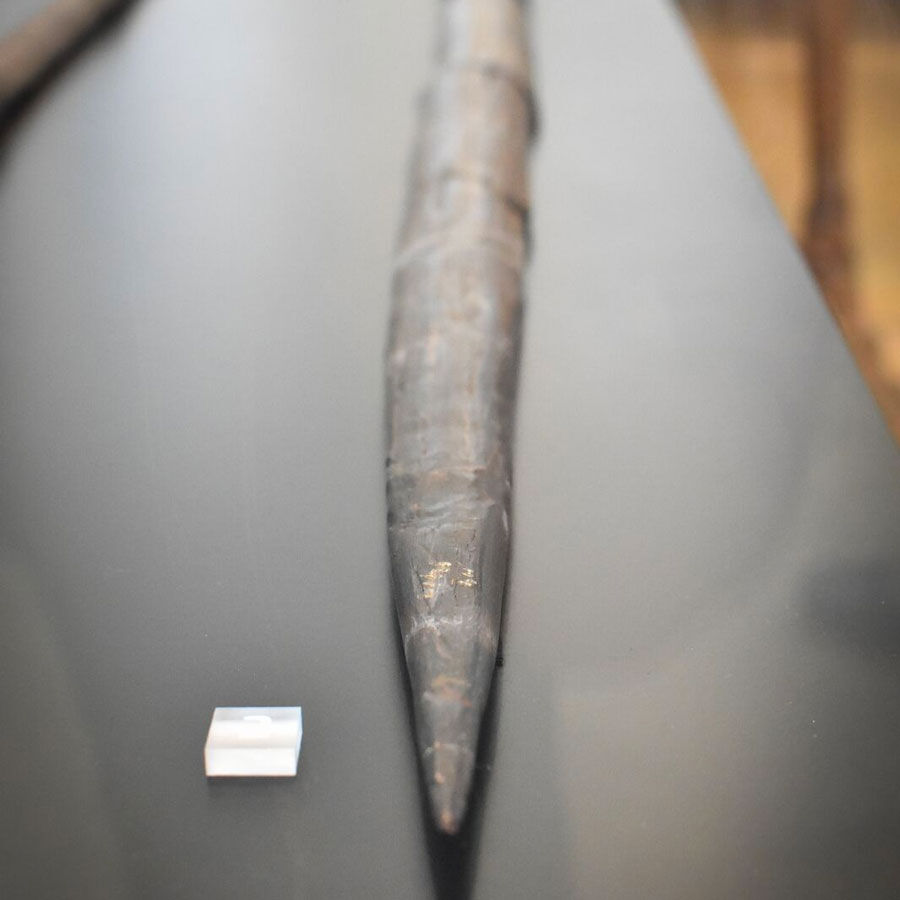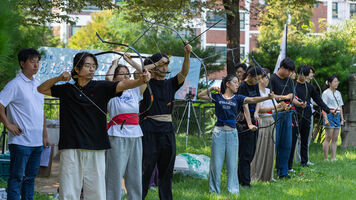How old is the bow and arrow?

For many decades, a wooden bow made from a single piece of wood from an elm tree has been lying quietly in a glass case on the ground floor of the national museum in the centre of the Danish capital city of Copenhagen.
(It’s just a couple of 100 metres away from Christiansborg Palace, which hosted the finals of the 2015 World Archery Championships.)
The bow is broken into five pieces. Whole, it measured 64 inches long and is a glowing, deep brown colour. It’s known as the Holmegaard bow and is one of several found in the early 20th century in the peat bogs on the island of Zealand.
At first glance, it’s not the most incredible sight in the world – especially for something so important. Because the Holmegaard bow is – officially – the oldest bow in the world. (Or, rather, it’s the oldest complete bow and the oldest thing that is unquestionably a bow.)
Holmegaard bow

The Holmegaard bow has been dated to around 7000 BC, in the Mesolithic era, making it nearly 10,000 years old.
This date is not in question because it is based upon the peat layers it was found in. Heavy formaldehyde preservative keeps it the same condition it was found since its removal from the safe, oxygen-free confines of the bog. But it has also prevented any more specific chemical or carbon dating.
The bow was made and used by people of the Maglemosian culture. They were sophisticated nomadic hunters who had jewellery, domesticated dogs and even decorated dugout canoes.
It’s striking how modern the Holmegaard bow looks. It’s elegant and symmetrical. It has a characteristic design with wide, tapering limbs and a deep, narrow, cutaway handle. The cross-section is a flat D-shape, like a modern English longbow, with a rounded back and a flat belly.
Modern bowyers have produced reproductions and found it to be highly efficient.
The wide limbs distribute the stress of drawing the bow well and reduce any chance of breakage, and the tapered limbs increase the speed imparted to the arrow.

As archery historian Jan Sachers pointed out, it was even manufactured efficiently. Close to 10 millennia ago, a bowyer somewhere in Northern Europe carefully selected a narrow trunk of knot-free elm that had grown in the shade. (Shaded elm wood produced a smaller and tougher grain.)
Using only the stone tools he or she had available to produce the final bow, taking such care over the selection of the wood would reduce the amount of time spent working it. The manufacturing process would not have been fast; it would have taken time, thought and knowledge.
The Holmegaard bow was not the first of its kind. It had been developed and likely gone through 1000s of previous iterations. It was a technical tool, likely produced by a specialist who had learned their craft from the many hundreds of bowyers – and many, many bows – that had preceded them.
So if this bow is the oldest known, but clearly not the first – just how old is the bow and arrow? The answer is buried deep in prehistory.
Human evolution

Fragments of arrows made of pine dated a few 1000 years older than the Holmegaard bow have been found at Stellmoor, near Hamburg, in Germany. There have been no older bows or arrows found – yet.
Wood does not usually survive from antiquity unless it has been preserved in a damp, oxygen-free environment, like peat. Despite the bow’s ubiquity across cultures and around the world, most of what we know about the early history of archery is interpreted from arrow points.
Arrowheads were made of flint long before they were made of metal – both substances that remain preserved much longer than wood.
In Europe, archaeologists have found triangular worked flints, which are almost certainly arrowheads, dating from the Solutrean period. This was around 20,000 years ago when humans started to migrate to North America.
(This dates between the Upper Palaeolithic, or Old Stone Age, and the Mesolithic, or Middle Stone Age.)
Constructing the kind of light, strong and sharp projectile points that could fit on the end of an arrow requires skill and is evidence of the cognitive capabilities of early humans. The ability to manufacturer such an advanced tool is key in human evolution.
Exactly when points were first added to a shaft and launched by a simple bent stick is still debated.
Projectiles
The basic concept of improving the ability of the human arm with tools goes far, far back. Archaic humans used projectiles such as spears – simple, sharpened pieces of wood – and darts to hunt animals 500,000 years ago.
Over the last 100,000 years or so, there was an explosion of technology.
The invention of the bow was preceded by the atlatl, a stick that gives leverage to throwing a spear or dart, and found almost everywhere across the globe.
Most recently, finds from a cave site in South Africa dating from 71,000 years ago have revealed complex stone blade points that resemble recent arrowheads, suggesting an even earlier origin for archery than widely thought.
The reason for the final combination of arrow and bow is speculative, but it is certain that this technology was so beneficial that archery spread to human cultures across the world. And, along with the invention of the wheel and the skill to make fire, is one of the few that persisted largely unchanged.
Invention

Can you imagine the ancient person who bent the branch of a small tree, let it go and, as the branch whipped back into place, wondered what the future possibilities were?
The elastic properties of certain types of wood were known to early man as there is evidence of spring traps. It’s even possible that the first bows may have been toys or some kind of musical instrument.
Perhaps more important than exactly when it was invented is what the bow represented.
Driven by the most basic instinct – hunger – the human mind was capable of incredible technological advances. The bow enabled people to hunt more efficiently, exploit previously unreachable land and was likely an immense display of power. It assisted in acquiring those vital extra calories that left time for other activities like construction, domestication and conversation.
Its development was a key station on the route to civilisation.
From the evidence, we know that the bow and arrow, in a modern and developed sense, is at least 10,000 years old. We’re pretty certain that arrowhead flints make archery at least 20,000 years old – and it’s possible that ancient humans were shooting bows 70,000 years ago… or more.
Thanks to Hugh Soar for his assistance. Images used with thanks under open license for educational purposes unless otherwise credited.









